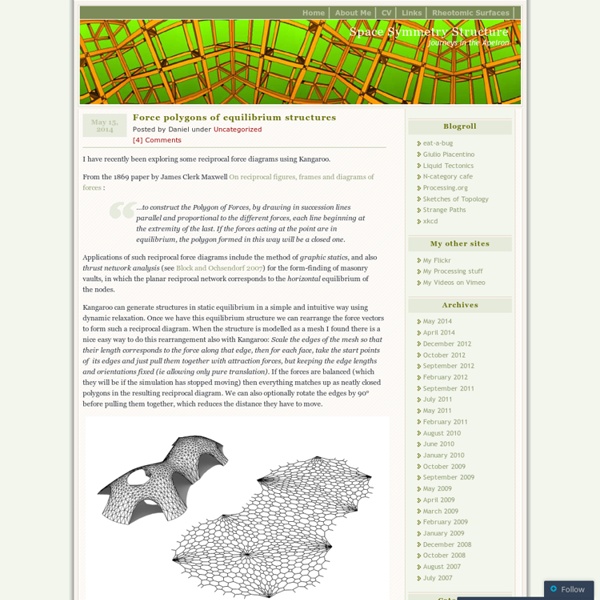



http://spacesymmetrystructure.wordpress.com/
Relational Geometries Each unique instance of the will be installed as an aggregation of raw, unsealed ceramic tiles. The climate, surface orientation, and potential shading by other structures will affect the ultimate growth and eventual disintegration of the wall. When installed in a shaded, colder environment, vegetation growth will spread slowly. The freeze thaw cycle of water penetrating the areas of unsealed ceramic tile will most likely cause the eventual disintegration of the wall. If installed in a warmer climate that receives optimal sunlight, the vegetation will rapidly take over the wall and cause it’s destruction.
Grasshopper (Explicit History) Same Area Voronoi using Galapagos I have been quite fascinated by the recent development of Galapagos for Grasshopper. This is a simple example of its application set up to solve for a 10-point voronoi division within a user-defined boundary where all the parts are divided as equally as possible in terms of their areas. I ran this with an initial population of a hundred for 200 generations. Relational Geometries 2009 This techniques seminar introduces students to the next generation of computer aided design tools that facilitate movement between digital modeling and material prototyping. Working from the idea of parametric design, the seminar methodically moves through a project exploring NURBS modeling, parametric modeling, rapid prototyping, mold making and material prototyping. The software environments that the seminar will introduce are Rhinoceros 4.0 and Grasshopper 0.5, while the rapid prototyping tools include the Universal Laser Cutter and the Dimension 3d Printer. We will begin by exploring the possibilities offered by NURBS modeling through Rhinoceros 4.0.
Fabrication Grasshopper: Parametric CurvesThis module covers the basic parametric properties of curves along with common grasshopper methods for evaluating and dividing curves. ARCH 598 Summer 2011information >> n-formations FABRICS // LATTICES // FIELDSThis course is designed to introduce and explore computational design, algorithmic thinking, and digital manufacturing–both: the larger ramifications that emerging digital technologies and ideas are having architectural theory via readings, discussions, presentations; and the practical application of these ideas and tools through a series of hands-on, iterative modeling and fabrication assignments. ARCH 581/498 : Fall 2010Digital Design + Fabrication Foundations I Grasshopper: Surface to Planar TrianglesGrasshopper : Surface to Planar Triangles : Fabrication Layout of Planar Components
grasshopper « un didi Follow Get every new post delivered to your Inbox. Join 50 other followers Powered by WordPress.com Waterbomb Tessellation and Beyond It all started with the platonic passion on origami tessellations, not much of the origami, but the tessellation part, as I didn’t want to fold it physically, nor model them using a physical engine such as Kangaroo. That would also be very unnecessary (and yes, very boring) to simulate a folding effort on computer unless we lose our connection with the real world. Instead, I tried to look at a much abstract, silly and basic part of it; the creasing patterns. I found below tessellation named “waterbomb” by the beautiful source of Eric Gjerde (here) to start an exploration.
Tutorial 3 - Reciprocal Systems - AAET picture: arup agu This tutorial will show how a reciprocal system can be constructed using Rhino, Grasshopper as design environment to inform a physical model. Download Tutorial as pdf - workshopsafd8-digitalmaterialandfabrication-tut3-reciprocal Download Rhino and Grasshopper file example of the GH definition colouring sticks by length
QT-tree L-system a(n) gives the net rotation (measured in right angles) after taking n steps along a dragon curve. - Christopher Hendrie (hendrie(AT)acm.org) This sequence generates A082410: (0, 1, 1, 0, 1, 1, 0, 0, 1, 1, 1...) and A014577[A014577 is the first difference of this sequence with symbols +1 -> 1 and -1 -> 0]; identical to the latter except starting 1, 1, 0...; by writing a "1" if a(n+1) > a(n); if not, write "0". E.g. A014577(2) = 0, since a(3) < a(2), or 1 < 2. - Gary W.
Data Tree Utilities: Match Path and Partial Flatten In the coming weeks, I am planning to release some clusters I've put together for use, and I thought I'd start with two that correspond to common operations I perform on data trees. The first, Match Path, takes a flat list of data with N items, and another list of data with N items with some kind of arbitrary tree structure. The output is the first flat list, reconfigured to match the path structure of the input list. I was inspired to create this one by a post on the Grasshopper board by Arie-Willem de Jongh (here). The second, Partial Flatten, takes a set of data with a tree structure and flattens the N lowermost levels of hierarchy. This has been requested a number of times as a built-in feature on the GH board - (see this thread for one example) but until it's implemented this cluster will have to do.
Parametric Joint Quick post about a metal joint design that is modeled parametrically. In a workshop course about structural design led by Renato Garcia, we are asked to research on joints. My group have decided to look at how custom joints are designed. This is particular interesting as we see more and more of them in new designs because of the desire to realize free form surfaces, it is common to see the construction of a structural framework composed of a mesh constructed with linear steel members, the joint conditions is particularly complex because it usually receives multiple linear elements from varying angles and pitches connecting to one point.